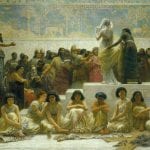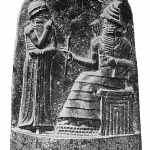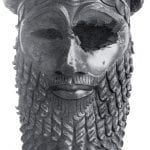Daily life in an ancient Mesopotamian city depended on a person’s status and occupation. Almost all societies and cultures are hierarchical with rulers at the top and laborers at the bottom. By the time people began living in cities, circa 4000 B.C., societies had different classes and a variety of occupations.
Life in a Mesopotamian city began early. Women would rise first and begin preparing a breakfast. In wealthy homes, slaves or servants would be the first ones up to get a meal together. Usually two meals were eaten daily, one in the morning before work began and one in the evening after work. The staples of Mesopotamian life were bread, beer and onions. Breakfast might include a porridge or a soup as well as bread with beer to wash it down. People also drank water and milk, though milk spoiled quickly in the hot climate.
“Mesopotamian Civilization: Gilgamesh, Sargon, and Why 1 GB of Information on Cuneiform Tablets Weights as Much as a 747”
For the full “History Unplugged” podcast, click here!
After breakfast, those who worked in or around their homes began their workday. Most women worked in their homes caring for their families, though some also worked as weavers, potters, tavern-keepers or bakers. Those whose work took them outside their homes usually carried some bread and beer for a middle of the day snack.
Every day included religious observances such as prayers before meals and requests for aid from the gods for many of life’s daily tasks. Mesopotamians made sacrifices to one god before beginning a building project and made sacrifices to another god when the building was complete. The gods were involved in all of life’s experiences and people performed specific rituals concerning the gods daily. This was the daily life in a Mesopotamian city.
City centers held the temples, ziggurats, the king’s palace and wealthy homes. Most cities spread out from this center with the poorer people living farther out. Cities were dotted with fruit and nut trees and some homes had gardens. Narrow, winding streets and alleys were the norm throughout most of the city except in the city center.
Daily life in a Mesopotamian city: Most city houses were made of sun-dried mud brick. Temples, palaces and homes of the nobility were also made of mud-brick, but these bricks were kiln-dried and of far higher quality. Most houses had two or three stories with flat roofs. In hot weather, people cooked, entertained and slept on their roofs.
After a working day, people headed home for the evening meal. Typically in the daily life in a Mesopotamian city, Mesopotamian women served bread, beer and onions at the evening meal along with a vegetable stew, a fish soup or on special occasions, roasted meats such as mutton or lamb. Grains such as barley and wheat, vegetables and fruit were eaten at every meal, flavored with herbs and spices grown locally or imported from afar.
Poorer Mesopotamians went to bed at dark so they didn’t have the expense of lighting candles or oil lamps. Wealthier homes had windows for lighting as well as sesame oil lamps. They also had braziers for heat and light in the colder times of the year.
This article is part of our larger resource on Mesopotamian culture, society, economics, and warfare. Click here for our comprehensive article on ancient Mesopotamia.
Cite This Article
"Daily Life in a Mesopotamian City: What Exactly Was It Like?" History on the Net© 2000-2024, Salem Media.
April 20, 2024 <https://www.historyonthenet.com/daily-life-in-a-mesopotamian-city>
More Citation Information.










